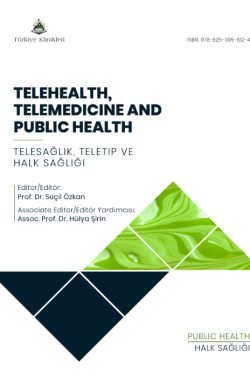Telemedicine and Disadvantaged Groups
Hülya ŞİRİNa , İbrahim Sefa GÜNEŞa
aUniversity of Health Sciences Gülhane Faculty of Medicine, Department of Public Health, Ankara, Türkiye
Şirin H, Güneş İS. Telemedicine and disadvantaged groups. In: Özkan S, ed. Telehealth, Telemedicine and Public Health. 1st ed. Ankara: Türkiye Klinikleri; 2024. p.31-6.
ABSTRACT
Nowadays, telemedicine has experienced a major transformation in the field of healthcare and has provided patients with better service delivery opportunities. However, it is a fact that these technological advances are not equally accessible to all segments of society. Disadvantaged groups are defined as groups that need protection and care compared to the majority of the society, have difficulty in participating in different areas of social life. Disadvantaged groups can include people with disabilities, the elderly, children and young people, migrants, women, illiterate people, people with economic inadequacy, single-parent families, the poor, homeless people, ex-convicts, rural dwellers, retired people, people affected by natural disasters, people with language barriers and different cultural structures and religions. This can complicate the implementation of telemedicine services for disadvantaged groups. Health organizations and governments should strive to develop solutions that are appropriate to the needs of these groups and help them overcome these barriers.
Keywords: Public health; telemedicine; vulnerable populations; remote consultation; telerehabilitation
Kaynak Göster
Referanslar
- Ryu S. Telemedicine: Opportunities and Developments in Member States: Report on the Second Global Survey on eHealth 2009 (Global Observatory for eHealth Series, Volume 2). Healthc Inform Res. 2012;18(2):153-5. [Crossref]
- Dilbaz B, Kaplanoğlu M, Kaya D. Teletıp ve Telesağlık: Geçmiş, Bugün ve Gelecek. EHTA. 2020;4(1):40-56.
- Mayer ES. What is a disadvantaged group? Minneapolis: Effective Communities Project. 2020.
- Arkan Z, İrez S. Türkiye'de ve Dünyada Dezavantajlılık (Sosyal İçerme Eğitim Programı). Proje İzleme Grubu. 1. Baskı. Ankara: Filmsan Reprodüksiyon ve Matbaacılık; 2023.
- UNESCO [İnternet]. Education strategies for disadvantaged groups, UNESCO working documents in the series IIEP contributions. 1998 [Erişim tarihi: 3 Kasım 2023]. Erişim linki: [Link]
- Tokol A. Özel Olarak Korunması Gereken Gruplar (Dezavantajlı Gruplar), In Sosyal Politika. Eskişehir: Anadolu Üniversitesi Yayını; 2014. p.174-96.
- Elmas A. 1923-2016 yılları arası hükümet programlarında dezavantajlı gruplar. SSS Journal. 2018;15:945-53. [Crossref]
- Estes RJ. Disadvantaged Populations. In: Michalos AC, eds. Encyclopedia of Quality of Life and Well-Being Research. Springer, Dordrecht; 2014. p.1654-8. [Crossref] [PubMed]
- UNESCO [İnternet]. Promotion of the Cultures of Disadvantaged Groups of the Population. 2012 [Erişim tarihi: 3 Kasım 2023]. Erişim linki: [Link]
- Unegbu VE. Expansion and redefinition of disadvantaged user groups in librarianship. GJMBR. 2012;12(19):96-100.
- Gür K, Samastı M. Akıllı şehirlerde dezavantajlı bireylerin sağlık hizmetlerine erişimi. Halk Sağlığı Hemşireliği Dergisi. 2021;3(3):234-48. [Crossref]
- Yılmaz A, Guven A. Kablosuz Hasta Takip Sistemi. Elec Lett Sci Eng. 2017;13(1):16-30.
- Tekin HC. Kronik Hastalıkların Uzaktan İzlenmesine Yönelik Teletıp Platformu. DEUFMD. 2020;22(64):37-46. [Crossref]
- Piette JD, Valverde H, Marinec N, Jantz R, Kamis K, de la Vega CL, et al. Establishing an independent mobile health program for chronic disease self-management support in bolivia. Front Public Health. 2014;2:95. [Crossref] [PubMed] [PMC]
- Azar M, Gabbay R. Web-based management of diabetes through glucose uploads: has the time come for telemedicine? Diabetes Res Clin Pract. 2009;83(1):9-17. [Crossref] [PubMed]
- Alipanah N, Jarlsberg L, Miller C, Linh NN, Falzon D, Jaramillo E, et al. Adherence interventions and outcomes of tuberculosis treatment: A systematic review and meta-analysis of trials and observational studies. PLoS Med. 2018;15(7):e1002595. [Crossref] [PubMed] [PMC]
- Bal U, Yılmaz E, Tamam L, Çakmak S. Telepsikiyatri: Şimdi ve Burada. Psikiyatride Güncel Yaklaşımlar. 2015;7(2):136-48.
- Choi NG, Wilson NL, Sirrianni L, Marinucci ML, Hegel MT. Acceptance of home-based telehealth problem-solving therapy for depressed, low-income homebound older adults: qualitative interviews with the participants and aging-service case managers. Gerontologist. 2014;54(4):704-13. [Crossref] [PubMed] [PMC]
- Sikka N, Gross H, Joshi AU, Shaheen E, Baker MJ, Ash A, et al. Defining emergency telehealth. J Telemed Telecare. 2021;27(8):527-30. [Crossref] [PubMed]
- Haleem A, Javaid M, Singh RP, Suman R. Telemedicine for healthcare: Capabilities, features, barriers, and applications. Sens Int. 2021;2:100117. [Crossref] [PubMed] [PMC]
- Annaswamy TM, Verduzco-Gutierrez M, Frieden L. Telemedicine barriers and challenges for persons with disabilities: COVID-19 and beyond. Disabil Health J. 2020;13(4):100973. [Crossref] [PubMed] [PMC]
- Haimi M. The tragic paradoxical effect of telemedicine on healthcare disparities-a time for redemption: a narrative review. BMC Med Inform Decis Mak. 2023;23(1):95. [Crossref] [PubMed] [PMC]
- WHO [İnternet]. WHO-ITU global standard for accessibility of telehealth services. 2022 [Erişim tarihi: 3 Kasım 2023]. Erişim linki: [Link]
- OECD. Understanding the Digital Divide, OECD Digital Economy Papers, No. 49. Paris: OECD Publishing; 2001. [Crossref]
- Payán DD, Frehn JL, Garcia L, Tierney AA, Rodriguez HP. Telemedicine implementation and use in community health centers during COVID-19: Clinic personnel and patient perspectives. SSM Qual Res Health. 2022;2:100054. [Crossref] [PubMed] [PMC]
- UNESCO. A Global Framework of Reference on Digital Literacy Skills for Indicator 4.4.2. Canada: UNESCO Institute for Statistics; 2018.
- BTK [İnternet]. Türkiye'de dijital dönüşüm ve dijital okuryazarlık. 2022 [Erişim tarihi: 3 Kasım 2023]. Erişim linki: [Link]
- Nouri S, Khoong EC, Lyles CR, Karliner L. Addressing equity in telemedicine for chronic disease management during the COVID-19 pandemic. NEJM Catalyst Innovations in Care Delivery. 2020;1(3).

